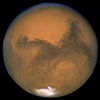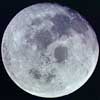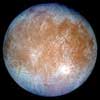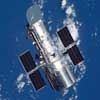|
Sunday:
April 4, 2004 | |
0457 GMT |
 |
Europe plans for Mars sample return mission
EADS Space has made significant progress in completing the first definition of a European Mars Sample Return mission. While EADS Astrium is defining the overall mission and the spacecraft, EADS Space Transportation is responsible for the re-entry systems and a 'Mars Ascent Vehicle' - a small rocket to carry the precious sample up through the Martian atmosphere.
 FULL STORY FULL STORY
 |  |

|
 |
New quasar studies set stringent limit
Detecting or constraining the possible time variations of fundamental physical constants is an important step toward a complete understanding of basic physics and hence the world in which we live. A step in which astrophysics proves most useful.
 FULL STORY FULL STORY
 |  |

|
 |
IN OTHER NEWS Additional stories making news today
|
 |
Launch nears for next station crew -- Plans for the next crew rotation on the International Space Station are on schedule. On Thursday, managers conducted a Stage Operations Readiness Review and found no constraints to the planned April 19 launch of the Soyuz carrying Expedition 9.

SpaceDev awarded $43 million for six MDA satellites -- SpaceDev announced that it has been awarded a five-year $43 million cost-plus-fixed fee indefinite delivery/indefinite quantity contract by the Missile Defense Agency (MDA) to conduct a micro satellite distributed sensing experiment, an option for a laser communications experiment, and other micro satellite studies and experiments as required in support of the Advanced System Deputate.
|
 |
|
Saturday:
April 3, 2004 | |
1631 GMT |
 |
Radio astronomers lift 'fog' on Milky Way's dark heart
Thirty years after astronomers discovered the mysterious object at the exact center of our Milky Way Galaxy, an international team of scientists has finally succeeded in directly measuring the size of that object, which surrounds a black hole nearly four million times more massive than the Sun.
 FULL STORY FULL STORY
 |  |

|
 |
Spots on Saturn
As Cassini closes in on Saturn, its view is growing sharper with time and now reveals new atmospheric features in the planet's southern hemisphere. This latest image was taken when the spacecraft was 35 million miles from Saturn, or slightly more than one-third of the distance from Earth to the Sun.
 FULL STORY FULL STORY
 |  |

|
 |
NEWSWIRE Links to news across the internet
|
 |
Metallic sound is heard by space crew -- (Associated Press) The two men aboard the international space station heard a strange metallic sound again Friday, four months after being startled by it the first time.
|
 |
|
Friday:
April 2, 2004 | |
0634 GMT |
 |
Spirit finds hints of past water at Gusev site
Clues from a wind-scalloped volcanic rock on Mars investigated by NASA's Spirit rover suggest repeated possible exposures to water inside Gusev Crater, scientists said Thursday.
Gusev is halfway around the planet from the Meridiani region where Spirit's twin, Opportunity, recently found evidence that water used to flow across the surface.
 FULL STORY FULL STORY
 |  |

|
 |

Additional coverage for subscribers:
 VIDEO:
WATCH THURSDAY'S MARS ROVER NEWS CONFERENCE QT VIDEO:
WATCH THURSDAY'S MARS ROVER NEWS CONFERENCE QT
 VIDEO:
SPIRIT EXAMINES MAZATZAL ROCK WITH NARRATION QT VIDEO:
SPIRIT EXAMINES MAZATZAL ROCK WITH NARRATION QT
 VIDEO:
IMAGERY OF 'BOUNCE' ROCK WITH NARRATION QT VIDEO:
IMAGERY OF 'BOUNCE' ROCK WITH NARRATION QT
 VIDEO:
PREVIEW OF OPPORTUNITY'S NEW COLOR PANORAMA QT VIDEO:
PREVIEW OF OPPORTUNITY'S NEW COLOR PANORAMA QT
 SUBSCRIBE NOW SUBSCRIBE NOW

|
Astronomer tells Congress of lunar water challenges
The discovery of accessible deposits of water on the moon would "profoundly" affect the economics and viability of a lunar base, a Cornell University astronomer said Thursday. Unfortunately, he said, recovering water deposits will not be an easy task, since they are likely to exist in the bottoms of very cold, permanently dark craters at the moon's poles.
 FULL STORY FULL STORY
 |  |

|
 |
Builders of ancient tombs, temples followed the stars
Two studies of ancient monuments in southwest Europe reveal the influence the Sun and stars had on their builders according to Dr Michael Hoskin, a historian of astronomy at Cambridge University.
 FULL STORY FULL STORY
 |  |

|
 |
|
Thursday:
April 1, 2004 | |
0240 GMT |
 |
Hunt for extrasolar Earth-like planets intensifies
An international group of astronomers are about to continue their hunt for extrasolar planets with an enhanced world-wide telescope network in May. They are hoping to secure the firm evidence for the existence of Earth-mass planets orbiting stars other than the Sun, which has so far eluded astronomers.
 FULL STORY FULL STORY
 |  |

|
 |
Calculating odds of other habitable 'Earths'
More than 100 planetary systems have already been discovered around distant stars. How many of the known exoplanetary systems might contain habitable Earth-type planets? Perhaps half of them, according to a team using computer modelling to calculate the likelihood of any 'Earths' existing in the so-called habitable zone.
 FULL STORY FULL STORY
 |  |

|
 |
Dozens of 'mini-galaxies' discovered by astronomers
A new survey made with the Anglo-Australian Telescope has revealed dozens of previously unsuspected miniature galaxies in the nearby Fornax galaxy cluster. They belong to a class of galaxies dubbed "ultra-compact dwarfs."
 FULL STORY FULL STORY
 |  |

|
 |
|
Wednesday:
March 31, 2004 | |
0505 GMT |
 |
Ocean waves forecast for Saturn's moon Titan
When the European Huygens probe on the Cassini space mission parachutes down through the opaque smoggy atmosphere of Saturn's moon Titan early next year, it may find itself splashing into a sea of liquid hydrocarbons. In what is probably the first piece of "extraterrestrial oceanography" ever carried out, scientists have calculated how any seas on Titan would compare with Earth's oceans.
 FULL STORY FULL STORY
 |  |

|
 |
Is Andromeda Galaxy a cannibal on our doorstep?
Astronomers have collected the first clear evidence that the Andromeda Galaxy, also known as M31, is pulling one of its bright satellite galaxies apart, and discovered 14 previously unknown globular clusters orbiting far from the center of M31 which could have been left behind when
Andromeda devoured their parent galaxies.
 FULL STORY FULL STORY
 |  |

|
 |
Searching for life on icy worlds of outer solar system
At present, we know of no worlds beyond our Earth where life exists. However, primitive organisms on our planet have evolved and adapted over billions of years, colonizing the most inhospitable places.
 FULL STORY FULL STORY
 |  |

|
 |
|
Tuesday:
March 30, 2004 | |
1643 GMT |
 |
Probe confirms methane in the Martian atmosphere
During recent observations from the European Space Agency's Mars Express spacecraft in orbit around Mars, methane was detected in its atmosphere. Whilst it is too early to draw any conclusions on its origin, exciting as they may be, scientists are thinking about the next steps to take in order to understand more.
 FULL STORY FULL STORY
 |  |

|
 |
Andromeda yields cache of stellar black holes
Astronomers have discovered ten previously unknown likely black holes in the Andromeda Galaxy by means of a powerful new search technique they have devised. The Andromeda Galaxy is the nearest neighboring spiral galaxy, 2.5 million light years away.
 FULL STORY FULL STORY
 |  |

|
 |
Ultraviolet astronomy in danger, scientists say
World astronomers are becoming very concerned about their ability to carry out observations in ultraviolet light following recent announcements about the future of the Hubble Space Telescope.
 FULL STORY FULL STORY
 |  |

|
 |
Reflector successfully deployed on MBSAT satellite
The 12-meter (40-foot) diameter furlable mesh reflector system successfully deployed aboard the MBSAT satellite early Monday. The craft was launched earlier this month aboard an Atlas rocket from Cape Canaveral.
 FULL STORY FULL STORY
 EARLIER LAUNCH COVERAGE EARLIER LAUNCH COVERAGE
 |  |

|
 |
|
Monday:
March 29, 2004 | |
1502 GMT |
 |
Cassini examines high winds on Saturn
Wind-blown clouds and haze high in Saturn's atmosphere are captured in a movie made from images taken by the Cassini narrow angle camera. In the movie, atmospheric motions can be seen most clearly in the equatorial region and at other southern latitudes.
 FULL STORY FULL STORY
 |  |

|
 |
Supernova remnant reveals magnesium in abundance
The Chandra X-ray Observatory image of N49B, the remains of an exploded star, shows a cloud of multimillion degree gas that has been expanding for about 10,000 years. A specially processed version of this image reveals unexpectedly large concentrations of the element magnesium.
 FULL STORY FULL STORY
 |  |

|
 |
NEWSWIRE Links to news across the internet
|
 |
Third space tourist preparing for orbit -- (Associated Press) The next civilian to be rocketed into orbit at his own expense won't just be enjoying the ride: Gregory Olsen, a scientist who made a fortune with optics inventions, plans to do some research during his $20 million trip to the International Space Station.

Next space crew passes pre-flight exam -- (Associated Press) The three-man crew headed to the International Space Station next month passed a preflight exam Monday at Russia's Star City cosmonaut training center, space officials said.
|
 |

